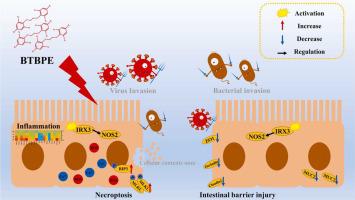Journal of Hazardous Materials ( IF 12.2 ) Pub Date : 2023-09-21 , DOI: 10.1016/j.jhazmat.2023.132597 Yuan Cui 1 , Qianqian Xiao 1 , Zhenyu Wang 1 , Qiong Zhang 1 , Yuetong Liu 1 , Weidong Hao 1 , Jianjun Jiang 1 , Qinghe Meng 1 , Xuetao Wei 1

|
新型溴化阻燃剂广泛应用于电子、纺织、家具等产品;它们可通过食入和呼吸进入人体对人体造成危害,并已被证明具有潜在的生物毒性和蓄积作用。1,2-双(2,4,6-三溴苯氧基)乙烷(BTBPE)是一种广泛使用的新型溴化阻燃剂;但对其毒性机制,尤其是肠道毒性的机制尚缺乏研究。目前,关于 iroquois homeobox 3 (IRX3) 功能的研究极其有限。在我们的研究中,分别在体内和体外对 Sprague-Dawley (SD) 大鼠和大鼠小肠隐窝上皮细胞 (IEC6 细胞) 施用 BTBPE,并使用苏木精和伊红 (HE)、免疫组织化学、阿新蓝-高碘酸-进行了 Schiff (AB-PAS)、CCK8、吖啶橙/溴化乙锭 (AO/EB)、荧光探针、qPCR、蛋白质印迹和免疫荧光分析。为了探索BTBPE的损伤机制,我们使用siRNA沉默IRX3和iNOs-IN-1(酵母提取物-蛋白胨-小麦;YPW)来抑制一氧化氮合酶2(NOS2)。结果表明,BTBPE 暴露引起空肠和回肠炎症和坏死性凋亡,以及紧密连接和粘液层的破坏。此外,BTBPE 在体内和体外均激活 IRX3/NOS2 轴。沉默 IRX3 或抑制 NOS2 可抑制坏死性凋亡并恢复 IEC6 细胞中的紧密连接。总之,我们的研究发现,在空肠、回肠和 IEC6 细胞中,BTBPE 暴露通过激活 IRX3/NOS2 轴导致坏死性凋亡和紧密连接破坏。阻断IRX3/NOS2轴可以有效抑制坏死性凋亡并恢复紧密连接。此外,BTBPE 暴露会导致空肠和回肠炎症和粘膜层损失。我们的研究首次探讨了BTBPE暴露引起肠道损伤的机制,并发现了IRX3/NOS2轴调控的新生物学功能,为坏死性凋亡和紧密连接提供了新的研究方向。
环境影响
BTBPE广泛存在于水、空气、土壤等自然环境以及日常生活相关活动中。BTBPE的广泛接触和长期积累使其毒性作用不容忽视。消化道是 BTBPE 暴露的常见途径。然而,目前缺乏BTBPE肠道毒性机制的研究。我们的研究首次探讨了 BTBPE 暴露引起肠道损伤的机制,并发现了 IRX3/NOS2 轴调控的新生物学功能。

"点击查看英文标题和摘要"































 京公网安备 11010802027423号
京公网安备 11010802027423号